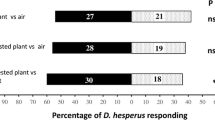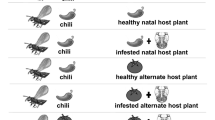Abstract
The sources of volatiles that attract the parasitoid Lariophagus distinguendus(Först.) to its hosts, the larvae of the granary weevil Sitophilus granarius(L.) infesting grains of Triticum aestivumL., were investigated in bioassays. The influence of oviposition experience on the responsiveness of the parasitoids to the sources of volatiles was considered. The potential sources of attractants are the host larvae, their feces, and the grain infested by the host. Weevil larvae were not attractive. Feces were attractive to females without and females with oviposition experience. Infested grains from which the larvae and feces were removed were slightly attractive to inexperienced, but very attractive to experienced females. Healthy and artificially damaged grains were attractive to experienced parasitoids only. Refering to the “variable response model,” we discuss the effect of experience on the response of the parasitoids to the several stimuli. Stimuli from different trophic levels are used by the foraging parasitoids: feces of the host larvae is an important source of attractants, but also the grains, particularly after experience.
Similar content being viewed by others
References
Agelopoulos, N. G., Dicke, M., and Posthumus, M. A. (1995). Role of volatile infochemicals emitted by feces of larvae in host searching behavior of parasitoidCotesia rubecula (Hymenoptera: Braconidae): A behavioral and chemical study.J. Chem. Ecol. 21: 1789–1811.
Alborn, H. T., Lewis, W. J., and Tumlinson, J. H. (1995). Host-specific recognition kairomone for the parasitoidMicroplitis croceipes (Cresson).J. Chem. Ecol. 21: 1697–1708.
Ambriz, S. J., Strand, M. R., and Burkholder, W. E. (1996). Behavioural response of the parasitoidLariophagus distinguendus (Först.) (Hymenoptera: Pteromalidae) to extracts from cocoons ofLasioderma serricorne Fab. (Coleoptera: Anobiidae) and their effects on subsequent oviposition responses.Biol. Control 6: 51–56.
Bellows, T. S. (1985). Effects of host age and host availability on developmental period, adult size, sex ratio, longevity and fecundity inLariophagus distinguendus Förster (Hymenoptera: Pteromalidae).Res. Popul. Ecol. 27: 55–64.
Cortesero, A. M., Monge, J. P., and Huignard, J. (1993). Response of the parasitoidEupelmus vuilleti to the odours of the phytophagous host and its host plant in an olfactometer.Entomol. Exp. Appl. 69: 109–116.
Cortesero, A. M., Monge, J. P., and Huignard, J. (1995). Influence of two successive learning processes on the response ofEupelmus vuilleti Crw (Hymenoptera: Eupelmidae) to volatile stimuli from host and host plants.J. Insect Behav. 8: 751–762.
De Jong, R., and Kaiser, L. (1991). Odor learning byLeptopilina boulardi, a specialist parasitoid (Hymenoptera: Eucoilidae).J. Insect Behav. 4: 743–750.
Dicke, M. (1994). Local and systemic production of volatile herbivore induced terpenoids: Their role in plant-carnivore mutualism.J. Plant. Physiol. 143: 465–472.
Eller, F. J., Tumlinson, J. H., and Lewis, W. J. (1988). Beneficial arthropod behavior mediated by airborne semiochemicals. II. Olfactometric studies of host location by the parasitoidMicroplitis croceipes (Cresson) (Hymenoptera: Braconidae).J. Chem. Ecol. 14: 425–434.
Eller, F. J., Tumlinson, J. H., and Lewis, W. J. (1992). Effect of host diet and preflight experience on the flight responses ofMicroplitis croceipes (Cresson).Phys. Entomol. 17: 235–240.
Geervliet, J. B. F., Vet, L. E. M., and Dicke, M. (1994). Volatiles from damaged plants as major cues in long-range host-searching by the specialist parasitoidCotesia rubecula.Entomol. Exp. Appl. 73: 289–297.
Godfray, H. C. J. (1994).Parasitoids, Princeton University Press, Princeton, NJ.
Hase, A. (1919). Beiträge zur morphologischen und biologischen Kenntnis der SchlupfwespeLariophagus distinguendus (Först) Kurdj.Sitzungsberichte Gesellschaft Naturforsch. Freunde Berlin 10: 402–432.
Hase, A. (1924). Über den Stech- und Legeakt, sowie über den Wirtswechsel vonLariophagus distinguendus. Chalcididae. Pteromalini.Naturwissenschaften 20: 377–384.
Hüsing, J. O. (1935). Über einen neuen ParasitenLariophagus distinguendus Först. (Hym. Chalc.) anPtinus fur L. (Col. Ptin.).Zool. Anz. 15: 324–326.
Kaschef, A. H. (1955). Étude biologique duStegobium paniceum L. (Col., Anobiidae) et de son parasiteLariophagus distinguendus Först. (Hym., Pteromalidae).Ann. Soc. Entomol. Fr. 124: 1–88.
Kaschef, A. H. (1959). Sur le comportement deLariophagus distinguendus Först. (Hym., Pteromalidae).Behaviour 14: 108–122.
Kaschef, A. H. (1964). Further studies of olfaction inLariophagus distinguendus Först. (Hym., Pteromalidae).Behaviour 23: 31–42.
Kirkpatrick, R. L., and Wilbur, D. A. (1965). The development and habits of the granary weevil,Sitophilus granarius within the kernel of wheat.J. Econ. Entomol. 58: 979–985.
Lewis, W. J., and Takasu, K. (1990). Use of learned odours by a parasitic wasp in accordance with host and food needs.Nature 348: 635–636.
Lewis, W. J., and Tumlinson, J. H. (1988). Host detection by chemically mediated associative learning in a parasitic wasp.Nature 331: 257–259.
Mattiacci, L., and Dicke, M. (1995). The parasitoidCotesia glomerata (Hymenoptera: Braconidae) discriminates between first and fifth larval instars of its hostPieris brassicae, on the basis of contact cues from frass, silk, and herbivore-damaged leaf tissue.J. Insect. Behav. 8: 485–498.
Mattiacci, L., Dicke, M., and Posthumus, M. A. (1994). Induction of parasitoid attracting pheromone in Brussels sprouts plants by feeding ofPieris brassicae larvae: Role of mechanical damage and herbivore elicitor.J. Chem. Ecol. 20: 2229–2247.
McAuslane, H. J., Vinson, S. B., and Williams, H. J. (1991). Stimuli influencing host microhabitat location in the parasitoidCampoletis sonorensis.Entomol. Exp. Appl. 58: 267–277.
Noldus, L. P. J. J. (1988). “The Observer”: An integrated system for event recording and data analysis in behavioural research. InProceedings, 18th International Congress of Entomology (Vancouver 1988), p. 228.
Peck, O. (1963). A catalogue of the nearctic Chalcidoidea (Insecta: Hymenoptera).Can. Entomol. (Suppl.) 30: 1–1092.
Petitt, F. L., Turlings, T. C. J., and Wolf, S. P. (1992). Adult experience modifies attraction of the leafminer parasitoidOpius dissitus (Hymenoptera: Braconidae) to volatile semiochemicals.J. Insect Behav. 5: 623–634.
Sachs, L. (1992).Angewandte Statistik, Springer-Verlag, Berlin.
Smirnov, E., and Polejaeff, W. G. (1937). On the behavior ofLariophagus distinguendus Först., a parasite of the granary weevilCalandra granaria L.Zool. Zjurn. 16: 999–1012.
Steinberg, S., Dicke, M., and Vet, L. E. M. (1993). Relative importance of infochemicals from first and second trophic level in long-range host location by the larval parasitoidCotesia glomerata.J. Chem. Ecol. 19: 47–59.
Tumlinson, J. H., Turlings, T. C. J., and Lewis, W. J. (1992). The Semiochemicals complexes that mediate insect parasitoid foraging.Agr. Zool. Rev. 5: 221–252.
Turlings, T. C. J., Tumlinson, J. H., Lewis, W. J., and Vet, L. E. (1989). Beneficial arthropod behavior mediated by airborne semiochemicals. VIII. Learning of host-related odors induced by a brief contact experience with host by-products inCotesia marginiventris (Cresson), a generalist larval parasitoid.J. Insect Behav. 2: 217–225.
Turlings, T. C. J., Tumlinson, J. H., and Lewis, W. J. (1990). Exploitation of herbivore-induced plant odors by host seeking parasitic wasps.Science 250: 1251–1253.
Turlings, T. C. J., Tumlinson, J. H., Heath, R. R., Proveaux, A. T., and Doolittle, R. E. (1991). Isolation and identification of the allelochemicals that attract the larval parasitoid,Cotesia marginiventris (Cresson), to the microhabitat of one of its hosts.J. Chem. Ecol. 17: 2235–2251.
Turlings, T. C. J., McCall, P. J., Alborn, H. T., and Tumlinson, J. H. (1993a). An elicitor in caterpillar oral secretions that induces corn seedlings to emit chemical signals attractive to parasitic wasps.J. Chem. Ecol. 19: 411–425.
Turlings, T. J., Wäckers, F. L., Vet, L. E. M., Lewis, W. J., and Tumlinson, J. H. (1993b). Learning of host-finding cues by hymenopterous parasitoids. In Papaj, D. R., and Lewis, A. C. (eds.),Insect Learning, Chapman & Hall, New York, pp. 51–78.
Turlings, T. C. J., Loughrin, J. H., McCall, P. J., Röse, U. S. R., Lewis, W. J., and Tumlinson, J. H. (1995). How caterpillar-damaged plants protect themselves by attracting parasitic wasps.Proc. Natl. Acad. Sci. USA 92: 4169–4174.
Udayagiri, S., and Jones, R. L. (1993). Variation in flight response of the specialist parasitoidMacrocentrus grandii Goidanich to odours from food plants of its European corn borer host.Entomol. Exp. Appl. 69: 183–193.
van Huis, A., Schütte, C., Cools, M. H., Fanget, Ph., van der Hoek, H., and Piquet, S. P. (1994). The role of semiochemicals in host location byUscana lariophaga, egg parasitoid ofCallosobruchus maculatus. In Proc. 6th Int. Work. Conf. Stored-Product Prot., Canberra, Australia, pp. 1158–1164.
Vet, L. E. M., and Groenewold, A. W. (1990). Semiochemicals and learning in parasitoids.J. Chem. Ecol. 16: 3119–3135.
Vet, L. E., Lewis, W. J., Papaj, D. R., and van Lenteren, J. C. (1990). A variable-response model for parasitoid foraging behavior.J. Insect Behav. 3: 471–490.
Vet, L. E. M., Lewis, W. J., and Cardé, R. T. (1995). Parasitoid foraging and learning. In Cardé, R. T., and Bell, W. J. (eds.),Chemical Ecology of Insects 2, Chapman & Hall, New York, pp. 65–101.
Author information
Authors and Affiliations
Rights and permissions
About this article
Cite this article
Steidle, J.L.M., Schöller, M. Olfactory host location and learning in the granary weevil parasitoidLariophagus distinguendus (Hymenoptera: Pteromalidae). J Insect Behav 10, 331–342 (1997). https://doi.org/10.1007/BF02765601
Received:
Revised:
Issue Date:
DOI: https://doi.org/10.1007/BF02765601




